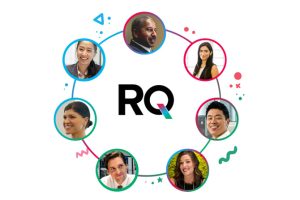Until recently, one of the basic tenets of leadership was to keep your distance from team members, their direct reports and even other leaders. The idea was to never get too close, or it would reduce your effectiveness as a leader.
This philosophy has been reinforced through innumerable catchphrases and nuggets of well-intentioned advice:
- “Leave your feelings at the door when you come to work …”
- “Never let them see you sweat …”
- “Keep your emotional distance from team members, or they will see you as weak and won’t respect you.”
While some of these axioms are more colorful than others, the message remained the same: “Stay tucked comfortably inside the ivory tower, or else people will begin to think you’re one of them.”
But let’s face it: those types of philosophies reflected archaic leadership methods and practices that didn’t work well then and are even less effective today. That’s why today’s most effective leaders and executives incorporate an approach known as “professional intimacy” into their management repertoire. It’s a term you may have heard, but for the uninitiated, let’s define exactly what it is — and what it isn’t.
Professional intimacy (also called corporate intimacy) describes a concept under the larger umbrella of Authentic Leadership.1 According to a recent article on Indeed.com,2 “Authentic leadership is one leadership style that emphasizes transparency, genuineness and honesty. Authentic leaders build genuine relationships with team members by inspiring trust and fostering a positive work environment.”
Professional intimacy, then, is an essential ingredient in the Authentic Leadership recipe that helps make it work the way it was intended.
In a professional context, intimacy should be viewed as close familiarity. It is NOT a romantic or erotic relationship that originates in the workplace. Nor does it refer to the common misunderstanding that genuine closeness automatically develops when individuals share secrets.
At its core, professional intimacy describes the process of letting the people with whom you work closely get to know “the real you” and vice versa. What’s more, it is meant to be used with no regard for a person’s title, position or responsibilities; the “real you” should be on display for everyone to see.
Bountiful Benefits
What is the outcome of all this newfound closeness and openness? According to an article in Psychology Today,3 professional intimacy holds the key to myriad corporate gains, including:
- Enhanced individual and team performance
- More effective senior leadership
- Reduced stress
- Increased happiness and fulfillment
- Improved communication by removing defensiveness
- Enhanced creativity
- A reduction in counterproductive “groupthink”
Given this laundry list of potential benefits, it’s no wonder more companies are viewing professional intimacy with much greater applicability. I’ve been personally involved with many companies aiming to make the transformation to a leadership structure that incorporated this approach. One example comes to mind that illustrates how professional intimacy can highlight the behavioral stumbling blocks that plague many people in the corporate environment — and how it can be instrumental in addressing and solving them.
I met a senior leader who was quite proficient at their job but closed off from sharing openly about themselves with team members. This came to light in team-building work, ongoing senior leadership team (SLT) meetings and, subsequently, in meetings with tangential team members.
Other members of the team also experienced a behavioral pulling back — or shutting down — from this leader. This was especially evident during emotionally intense work, such as assignments where significant financial stakes were in play.
As a coach working with several SLT members, I noticed it and wondered why the leader operated this way, almost as if they were reveling in their introversion.
I implored the CEO and other SLT members to ask this leader questions that would encourage opening up after demonstrating it was safe to do so. It was necessary to look below the surface of the behavior (pulling back) to gain an understanding of why they learned to operate this way, to uproot it and, ultimately, change it.
The key that made this possible was leaning into this particular leader with the safe inquiry: “I noticed a pulling back when XYZ happened. Where does that originate?”
Turns out, this leader’s mother was on food stamps and welfare when he was younger. He experienced shame and embarrassment from it and subconsciously vowed to do anything and everything to avert it in the future. Due to being poor, he was also bullied in middle school, so he viewed being authentically open about himself as a way that others could exploit what he considered to be a weakness and hurt him. This insight proved extremely valuable in helping this leader break down psychological walls and begin to feel more comfortable opening up to professional colleagues.
Explaining the Unexplainable
While getting to know your team members can make your business better, more profitable and more efficient, there are other, less tangible benefits that are still highly desirable. When you know what is important to team members and what motivates them on a personal level, it’s possible to illuminate previously unexplainable behaviors and either align with them or effect a transformation. It’s similar to knowing their core values but on an expanded basis. Two questions that often prove to be highly revealing are:
- “What motivates this leader to come to work here specifically?”
- “What are the most important things that create an environment which encourages growth?”
While these questions are intended to elicit positive responses, certain questions that root out negative feelings are just as useful, such as:
- “What are the things that will cause this leader to shut down, pull back or disengage — or even cause them to start looking to leave the company or pull back from the team?”
- “What is the biggest challenge this leader experienced growing up that created how they show up at work?”
To understand why these types of questions need to be asked and answered, remember that each team member is like the spoke of a wheel. If one spoke is loose, the wheel will stop rolling/performing well. There will be bumps that slow down collaboration and hinder the feeling of being secure enough to share their creativity because they fear not being accepted for who they really are. Consequently, they assume a “persona” that is all about work; however, the persona isn’t sustainable within a team that is aiming for high-level results or is pioneering new methodologies.
When all team members feel safe enough to open up and show their true selves, they subconsciously realize they can count on each other, no matter what work situation the team encounters. They realize that their positions are stable as long as they stay authentically open and are willing to work on improving. Conversely, when no one bothers to look below the surface — enabling the pullback — the leader feels let down and subconsciously interprets this seeming indifference as proof that they are on shaky ground. Thus, a repeating cycle ensues until it’s interrupted.

“4 Questions, 4 Minutes”
One of the methods we use with senior leadership teams to elicit openness is a life-changing exercise called “4 questions, 4 minutes.” It’s life-changing because each time we take a team through it, every leader claims it allowed them to learn things about their peers they never knew while creating a framework for them to do the same. Here are the questions we ask (and we encourage team members to jump in and ask additional questions as each one shares):
- Where are you from, and where did you grow up?
- Where are you in your family’s birth order?
- What were you good at, or what did you like doing while growing up?
- What is the most challenging thing you experienced growing up that creates how you show up at work?
It is truly amazing how these simple four questions get leaders to open up, revealing who they really are under their professional exterior. On one leadership team, we found instances in which 60% of the leaders were from four-sibling families, and all held the same place in the birth order. Two of them never felt like they were accepted for who they were; they put on a “work persona,” choosing not to let team members see their true selves.
Despite the obvious upsides of professional intimacy, certain precautions must be observed. The most obvious is, can professional intimacy go too far? Does it mean knowing the business and career aspirations of your team members, or can it venture into the personal (for example, knowing their kids’ names, their favorite sports team, etc.)? Ultimately, it can be both, as it’s important to know the entire person.
Can a line be crossed when trying to establish this intimacy? Are there any “guard rails” that leaders should observe? A good rule is to stick to using the doorway of how these leaders show up at and through their work. Along the path of sharing, invite them to reveal familial facts, aspirations, dreams, hopes, fears and beliefs; but don’t feel slighted or discouraged if it appears that the person’s comfort level begins to decrease due to this unfamiliar sharing process. They will continue to open up over time as their subconscious confirms it’s safe to do so.
R U Proficient at RQ?
The “4 questions, 4 minutes” exercise, while instrumental in nurturing professional intimacy, is one element in a larger concept known as Relationship Intelligence Quotient, or RQ.
Quite often, the quality of our relationships at work determines the quality of our work and, ultimately, our success. Stronger work relationships give birth to more meaningful discussions, more innovative solutions and better business outcomes.
If you’d like to engage in a FREE inventory of your own Relationship Intelligence Quotient, contact Exponential Results or click the link below.
Explore Relationship Intelligence (RQ)
This is a proven, cutting-edge system used globally by companies of all sizes. The inventory takes approximately 30 minutes to complete, and you will have immediate access to your results.
Karen Brown is the CEO of Exponential Results, a full-service leadership development firm that elevates leadership skill and performance of Director through C-suite. Get in touch with her at karen.brown@yourexponentialresults.com.







